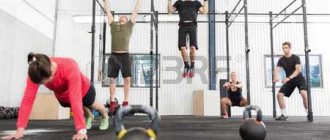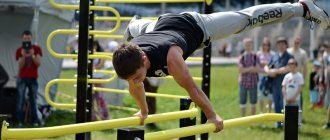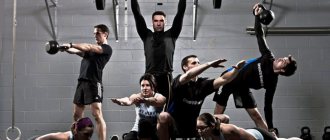Due to the variety of directions, sometimes it is difficult to choose and decide on the only correct and suitable one for yourself. When people hear about a new method of training the body, many are too wary, justifying it by saying that such changes in the program will affect the effectiveness and will do more harm than good.
This is not always true, for example, cross-fitness is one of the most interesting and promising areas.
Until recently, few people in the world knew about the CrossFit direction - what it is and why such a system is applicable.
Fitness crossfit
In simple terms, the essence of the definition of CrossFit is that it is a type of circuit training during which exercises are performed in a circuit pattern over short periods of time. CrossFit has a number of differences from standard circuit training:
- The complex includes loads that allow you to work out a whole group of diverse human qualities. Among them are strength, agility and endurance. Therefore, all CrossFit workouts are conventionally divided into several stages - the stretching stage, cardio training and weightlifting.
- The cross-fitness program does not include isolated exercises. It makes no difference whether the muscles are worked using a machine or free weights. The main goal is to prepare the body for heavy loads. The training program includes exercises such as pushes, pulls, presses, snatches, etc. Anything can be used as equipment, be it dumbbells, barbells or weights.
- The program also includes bodyweight exercises, such as the bar or rings. Various types of jumps, jumps, etc. are also used here. A significant advantage is the availability of classes to increase endurance. In this case, a jump rope or a bicycle (exercise bike) are good options. It is recommended to swim and run a lot.
- There are no strictly fixed competitions in cross fitness. For example, at tournaments, athletes can freely select a set of exercises and also decide in what order to combine them. For example, you can develop agility-strength, strength-endurance, etc. at once.
- A training program is created individually for each athlete and many parameters are taken into account. Everything influences: the individual characteristics of the body, the equipment of the hall, the availability of equipment, and the like.
- To master the technique and a famous CrossFitter requires a good coach and the development of several components - patience, will and desire to achieve results.
Two training goals
What is training, not in terms of format, but in terms of purpose? It is a teaching method that helps a person solve a specific problem. And he does this in two ways. Firstly, by providing a person with tools that allow them to achieve the desired effect, overcoming all obstacles. In this case, the training will be called instrumental. Secondly, the training can be aimed at instilling the skills of a general vision of the problem and mastering the basic mechanisms of its occurrence and solution for independent adequate selection of specific tools. In other words, a person is given not one specific “pill” for a problem, but an understanding of the concept - knowledge of how, when and what kind of “pill” needs to be made and taken in each particular situation. This is what training is called fundamental.
Workout Features
The main thing that requires attention is basic exercises . These include: squats, deadlifts, presses, etc. The main goal is to learn the technique of performing exercises correctly. At the same time, it is necessary to study the rules of gymnastics, i.e. various stretches, rope climbs, bends, push-ups, etc.
The training program necessarily includes running exercises, somersaults, cycling, swimming, and so on. Having chosen a set of exercises for yourself, you should start combining them and at the same time doing 4-6 times a week. You need to diversify your workouts as much as possible.
Typically, the training scheme in CrossFit is 3:1 - three days of training with one day of rest. If this scheme is too difficult, then you can work 2 by 2 and gradually switch to the mode described above.
https://youtu.be/0oQPc9Nzcbk
History of the training
The term “training” itself came to us from the English-speaking world. One of its influential supporters and disseminators as a teaching method was Dale Carnegie, who at the beginning of the 20th century created a training center named after himself, where he more than successfully taught public speaking and other socially significant skills.
But training received its real birth in psychology thanks to the work of the well-known Kurt Lewin, who with his supporters created training groups for people complaining of low communication abilities in the 40s of the last century. The format of his classes showed such impressive results that soon an entire training academy was created in the USA. Since then, this method has been an integral part of both the educational process and personal development in various areas of life, for example, in family relationships and in business.
CrossFit contraindications
- Having problems with the respiratory or cardiovascular system;
- Pregnancy;
- Injuries of the musculoskeletal system;
- Recent surgeries;
- The presence of an acute illness;
- Acute infectious diseases;
- CNS lesions;
- Problems with the liver, kidneys, biliary or urinary tract;
- Mental problems;
- Gastrointestinal diseases.
If you decide to take up CrossFit, you must be prepared to carefully follow the training regimen, determine the work area, accurately perform each exercise, correctly combining it with rest and thereby giving the body time to recover.
https://youtu.be/LXPoTx9VEJM
What is training?
What is training?
You can have a very interesting half-hour session with a group, defining the concept of training. The following answer options may arise:
This doesn't happen at work.
This happens at work.
It's showing someone how to do something.
The training provides a set of goals that the participant must achieve.
Training is sometimes perceived as something related to work - on-the-job training, off-the-job training, recruitment training schemes. Often, training is considered a formal process, whose components: the presence of a trainer in the training room and the availability of handouts are in the hands of the participants. Underlying active learning
The principles
learning
, individual learning styles, active listening skills, asking questions and giving feedback are applied in training in the same way as in regular teaching, lecturing, coaching and assessing individual qualities. It is natural to expect that the training will have its own goals and objectives, structured content and methods for assessing results.
Training involves countless options, depending on the coaching style and approach, and the prerequisites for the training. If all the options are arranged along one line, at one end there will be so-called trainer-facilitators, using a small number of formal exercises and relying on their own experience in generating ideas within the group. They are more focused on achieving results than others. At the other end of the scale are the more traditional “skill set” coaches who may feel very at ease in a speaking environment. Their style is, first and foremost, informative. Both of them conduct trainings. However, the experience participants have will vary greatly. Both approaches have their advantages and disadvantages.
Trainer facilitators work well with groups. Through their own creativity and energy, they facilitate and encourage the inclusion of all group members in the work.
More traditional trainers may find this approach too difficult to replicate. They strive to teach others certain behaviors. Their leadership style may be more directive, and many are accustomed to acting as experts.
To effectively implement training in modern conditions, it is necessary to combine the active involvement of participants with measured presentation of information.
It is important for group members to feel that the coach has personally conveyed something very valuable to them. This could be a model, process or information
Participants do not want to conclude that the trainer has not taught them anything new. There's an old story about consultants who borrow your watch, tell you what time it is, and then demand a fee for it.
In the section “Change as an effect of training and development (T&D)” we will talk about the fact that training itself is a change. Many traditional training centers have disappeared. Instead, educational centers, centers instructing line managers, and special on-site motivational training have emerged. Today's organizations view attending any training as a serious investment and expect it to provide financial benefits and advance their overall business goals.
Perhaps in the future the term “training” itself will disappear. Instead, words such as “active learning”, “development” or “transfer of activity style” will appear, or completely other terms that we don’t even think about today.
Resistance to the urge to recalculate meetings
When working with large, diverse, disparate teams, it can sometimes take weeks to schedule every meeting for a meeting. Regular meetings also become frustrating from the moment your team starts working on their regular tasks. For these reasons, it is important to limit the number of joint functional collaboration meetings to a minimum amount of time. Make sure you use new technologies such as communication and collaboration tools. KaiNexus, for example, uses tools such as Google Docs, GoToMeeting and, in fact, KaiNexus. Continuous Improvement software is a great way to get teams to collaborate between meetings. This makes your other meetings more productive, and also helps in identifying and analyzing problem areas of cross-functional collaboration.
When you absolutely must meet, there should be a strict agenda, a single notebook, and a clearly defined method for documenting follow-up tasks. Employees often set a timer on their cell phone to limit the amount of time they can discuss a particular topic. A surefire way to ensure that the meeting ends on time is to remove the chairs from the meeting room!
Cross-Training What Why
What is Cross-Training?
Cross-training is training in a sport or activity other than your main sport. If rowing is your main sport then you can cross-train by running, cycle, swimming or performing any other sporting activity.
Why Cross-Train?
There are several reasons, both physiological and psychological, why athletes should consider cross-training.
In physiological terms, cross-training is used to improve the performance of an athlete in one sport by borrowing methods and movements from other sports. Sports which involve repetition, such as rowing, put participants at risk of developing overuse injuries as muscles, tendons and ligaments are stressed over a period of time. Cross-training acts as supplementary training, aiming to reduce the risk of overuse injury of particular muscles or joints. Cross-training can allow rowers to improve their fitness levels without risk of developing lower back injuries, rib stress-fractures or wrist problems.
Rowing is a repetitive-motion sport where production of high levels of force is required. This kind of movement leads rowers to overdevelop certain muscles and to work joints in limited directions. The risk is that rowers become too specific. They may lose the 'balance' of their muscle groups and the strength and flexibility of joints, leading to injury when performing other activities. Cross-training works the body outside of the usual rowing motion to help maintain strength and flexibility in non-rowing movements. The aim is to build a more robust athlete and lower the risk of future injury by keeping a rower off the water.
Not only can cross-training be used to help prevent injury but also to rehabilitate athletes during recovery. Rowers with upper body injuries can maintain their fitness levels through sports such as cycling or running which isolate the injury while still working the lower body and the cardiovascular system.
A change is as good as a rest. In psychological terms, cross-training provides something different. Even the most enthusiastic rowers will tire of long ergo sessions over the winter. Cross-training can alleviate the boredom of the winter training program. While sessions on the rowing machine also help to improve technique, much of the time spent in these sessions is on developing a rower's fitness. Similar fitness gains can be found by substituting some of these sessions for other sports. This gives rowers a new activity to challenge themselves with and helps to keep the ergo sessions from becoming routine and repetitive.
We're not all professional rowers and sometimes real life can get in the way of our ideal training program. When work or lifestyle constraints mean you can't get to the boathouse, or find a rowing machine, cross-training comes into its own. Activities such as running require virtually no equipment and can be done almost anywhere. Can you save time in your day by commuting by bike and squeezing in a cycling session when you'd normally be driving? By using some imagination and whatever you find around you it's possible to follow a demanding training program despite a busy schedule.
Difficulties associated with mistrust
Cross-functional collaboration involves teams from across the organization tasked with working on the same project or finding a solution to a specific problem. In theory this sounds ideal. Different skill approaches are provided to approach a project from multiple angles. Sounds like a thorough, efficient method, right? But not everything is so simple! After all, some people don’t even know how to spell “cross-functional collaboration.” This method is a kind of innovation in management, and therefore has its drawbacks that have yet to be overcome.
When employees and managers view an organization as a group of dividing, divided groups, the result is “tribalism,” or the emergence of competing “blocs” within the company. When there is a lack of trust between such “blocs,” any cooperation fails.
Leaders can help overcome the conflicting interests of these divided groups and create a culture of trust by aligning common goals and incentives for the organization as a whole, rather than encouraging the selfishness of individuals and departments. If mistrust is a barrier to collaboration in your organization, try starting with a few small tasks for teams to collaborate on to get quick results. Seeing results can help develop trust.










